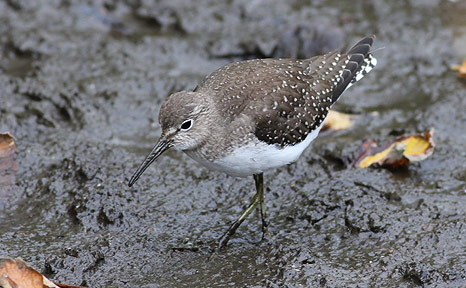The Isles of Scilly have long enjoyed a reputation for sightings of American birds in September and October but in recent years the Atlantic weather systems responsible for bringing these lost migrants to Europe have tended to track north and brought rarities to Scotland whilst South West England has suffered a relative paucity of records.

Solitary Sandpiper by Pauline Blewitt
Fortunately for the recent Naturetrek group, following the passage of several fierce hurricanes along the US seaboard, Scilly once again played host to an arrival of Nearctic species this year and the group experienced a vintage week which will long be remembered by all the participants.
The pattern for the week was established on the first morning of the tour with prolonged close-up views of a European Bee-Eater followed within a few minutes by a Solitary Sandpiper feeding within a few metres on the mud of a somewhat dry Newford duck-pond and the unexpected arrival of a female Blue-winged Teal which seemed glad to have found the small pool of water still remaining. Elated by this great start we resumed our planned walk along the coast of St Mary's and were soon admiring a flock of 4 Buff-breasted Sandpipers with a Dotterel on the airfield whilst a big Peregrine soared over the runway causing panic among the waders. It was not yet noon on our first full day and we could be forgiven for thinking that we had already used up our quota of luck but there was much more to come and by the end of our stay we had seen an astonishing 8 species of American bird as well as more regular migrants such as Ortolan, Lapland Bunting, Mediterranean Gulls and Grey Phalarope. Perhaps the greatest excitement for visiting birders was the occurrence of four passerines from North America, all obligingly within easy reach of our guest house accommodation in Hughtown. A somewhat elusive Red-eyed Viro along the Garrison walk to Morning Point was followed by an even more frustrating Black and White Warbler inhabiting swampy thickets of bushes in the Lower Moors Nature Trail but with perseverence on the one rainy day of the week we were eventually successful in obtaining close views (although not without getting soaked in the process! ) A handsome Baltimore Oriole on the Garrison was much easier to observe as it fed on blackberries and sat preening in nearby hedges but the fourth species, a Northern Waterthrush, was another test of resolve requiring us to brave ferocious mosquitoes and wet feet to catch its dawn and dusk appearances on a small reed-fringed pool near the rubbish dump. The final American species was perhaps a more predictable one as Pectoral Sandpipers appear on this side of the Atlantic with some regularity each autumn. We had three on Tresco and singles on St Agnes and St Mary's but as many as 9 had been counted in the preceding week.
It is perhaps invidious to concentrate on the rarities alone as these were just one aspect of a typically enjoyable week on the islands. Other highlights included 70 or 80 Grey Seals posing around the Eastern Isles, a Prickly Stick Insect at Old Town and brief views of a Minke Whale during the crossing back to Penzance followed by a pod of dolphins competing with diving Gannets. Mention also has to be made of many refreshing cafe stops, good company and mostly pleasant weather, all contributing to an exceptional autumn break even by Scilly standards!
To find out more about our tours to the Isles of Scilly, please click here.



 Loading search...
Loading search...